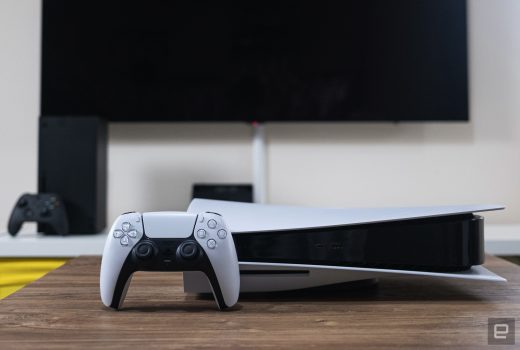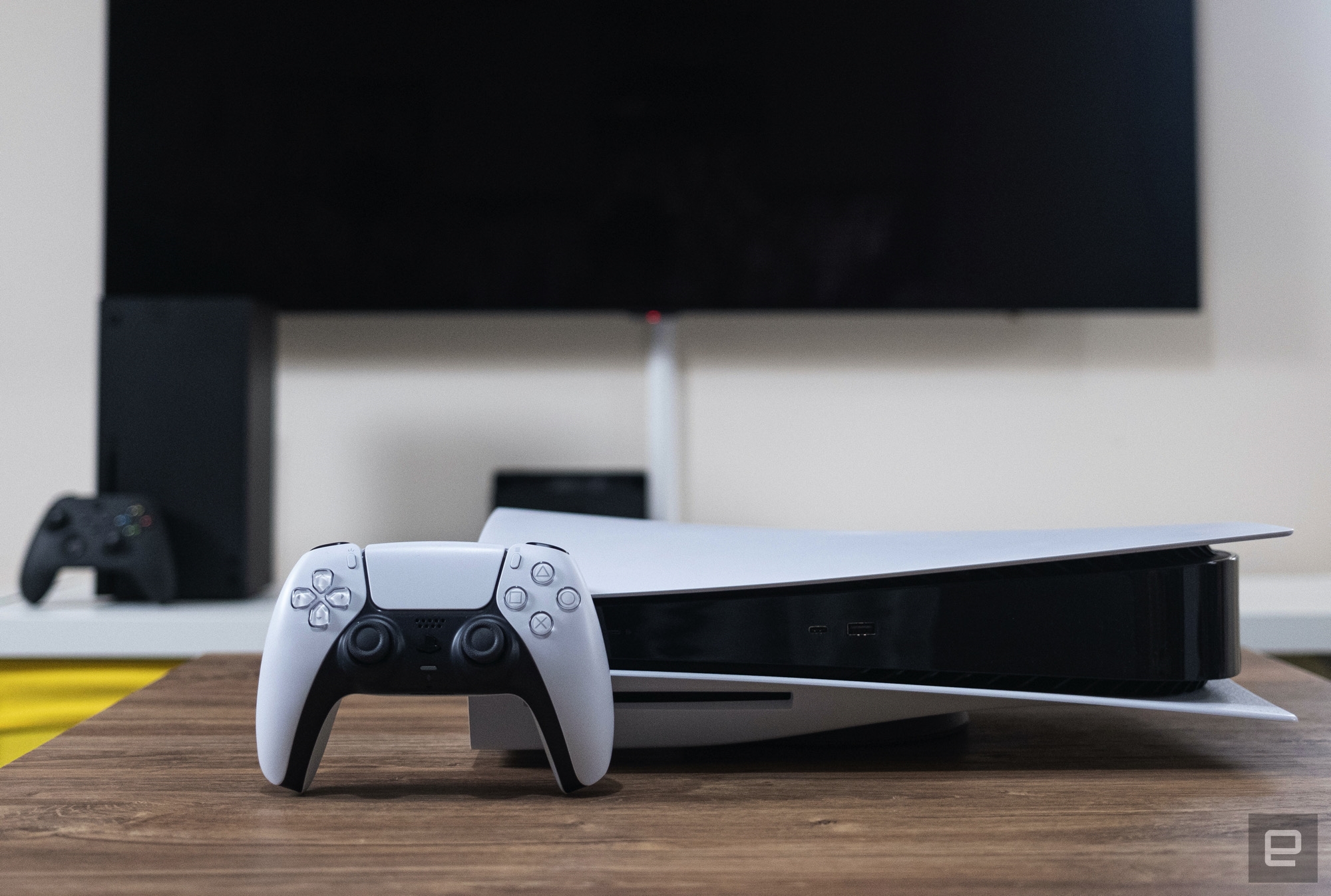The best SSD for your PlayStation 5
The best SSD for your PlayStation 5
And a step-by-step guide on how to upgrade.

With the upcoming system software update — currently in beta testing — you’ll be able to increase your storage by slotting in a standard PCIe Gen4 x4 M.2 NVMe SSD. If that mess of acronyms has you recoiling, don’t worry, you’ll see that it’s not all that complicated, and if you want to know which drives we recommend, you can skip to the end.
How much storage do I need?
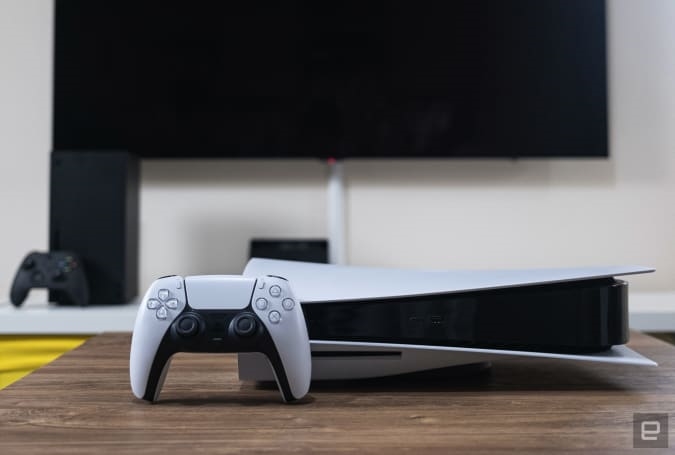
The PS5 will accept drives between 250GB and 4TB in capacity. If you already have a PlayStation 5, chances are you have a reasonable idea of how much storage you want. If you’re buying an SSD with a new PS5, or buying for someone else, though, it’s difficult to tell.
PS5 games are a little smaller on average than their PS4 equivalents, typically ranging between 30GB and 100GB, with some notable (and very popular) exceptions. If you’re a fan of the Call of Duty series, just having Cold War multiplayer and Modern Warfare/Warzone installed will require 307GB of space. A full Warzone–Modern Warfare–Cold War install will take up almost two thirds of the PS5’s internal storage. If you’re not a CoD fan, though, chances are you’ll be good to store between six to 10 games on your PS5 internally before running into problems.
One additional thing to consider is your internet speed. If you live in an area with slow broadband, the “you can just download it again” rationale doesn’t really work out. A 100GB download takes me around eight hours, during which time it’s difficult to simultaneously watch Twitch or, say, publish articles about upgrading PS5 SSDs. Keeping games around on the off-chance you’ll want to play them at some point make sense, at least for my household.
Off the bat, there’s basically no point in going for a 250GB drive. Economically, 250GB drives aren’t that much cheaper than 500GB, and practically, that really isn’t a lot of space for modern games to live on. 500GB drives, coming in at around $90 to $150, are a decent bet, but the sweet spot for most is to opt for a 1TB drive, which should run you between $160 and $250. That will more than double the space you have available for games without breaking the bank. (Seagate’s official 1TB Xbox Series expansion card, for comparison, sells for $220.)
If you have the money, 2TB drives sometimes offer marginal savings per gigabyte, and can often be found when other models are out of stock. Unless you’re rolling in cash and want to flex, 4TB models should mostly be avoided, as you’ll end up paying more per gigabyte than you would with a 1TB or 2TB drive.
One final note: While the 825GB PS5 only provides 667GB of storage, that’s largely due to storage being reserved for the operating system and caching. If you install a 1TB SSD, you’ll have, within margin of error, 1TB of storage available for games.
What about external SSDs?
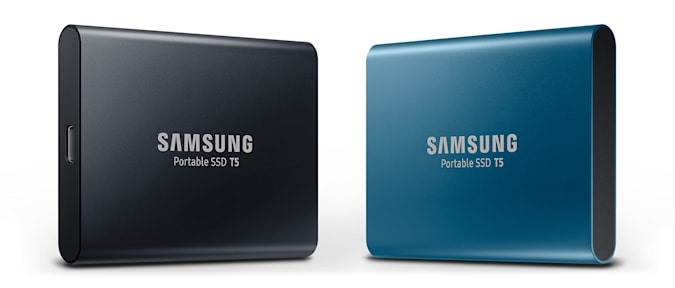
These are dramatically cheaper than the high-end internal SSDs, but there are restrictions on what you can do with them. An external SSD connects to your PS5 via USB, and is only suitable for playing PS4 games, or storing PS5 titles. This is useful if you have anything but the best internet — it’s faster to move a PS5 game out of “cold storage” on an external drive than it is to re-download it — or just want a large number of PS4 games to hand.
Due to the limitations here, you don’t need the highest performing model, although you should opt for SSDs over HDDs for improved transfer speeds. Any basic portable drive from a reputable brand will do, with the Crucial X6 and Samsung T5 being options we’ve tried and can recommend.
What SSDs are compatible with PS5?
The official answer to this question is an “M.2 Socket 3 (Key M) Gen4 x4 NVME SSD.” But even within that seemingly specific description, there are still more things to consider. The main requirements Sony has laid out for compatibility come down to speed, cooling and physical dimensions.
For speed, Sony says drives should be able to handle sequential reads at 5,500MB/s. Early testing has shown that drives as slow as 4,800MB/s are accepted by the PS5, and using them to play a game that taps into the SSD regularly — such as Ratchet & Clank: Rift Apart — causes no issues. Pretty much the only thing the PS5 will outright reject is one that doesn’t match the Gen4 x4 spec.
In our opinion, though, using a drive slower than the specification is a risk that, if you don’t already have that drive lying around, is not worth taking. Just because we haven’t found issues now, that doesn’t mean there won’t be games that will be problematic down the line. The price difference between these marginally slower Gen4 drives and the ones that meet Sony’s spec is not huge, and you may as well cover all your bases.
Slightly more complicated than speed is cooling and size. Most bare SSDs are going to be just fine; the PS5 can fit 22mm-wide SSDs of virtually any length (30mm, 42mm, 60mm, 80mm or 110mm, to be precise). The vast majority of drives you find will be 22mm wide and 80mm long, so no problem there.
It should be noted that the system can fit a 25mm-wide drive, but that width must include the cooling solution. Speaking of, Sony says SSDs require “effective heat dissipation with a cooling structure, such as a heatsink,” which is where most of the complications arise.
The maximum height supported by Sony’s slot is 11.25mm, of which only 2.45mm can be “below” the drive. This is intensely specific, and rules out some popular heatsinked Gen4 SSDs such as Corsair’s MP600 Pro and Sabrent’s Rocket 4 Plus. With time, it’s likely that manufacturers will want in on this new avenue for high-end SSD sales, and these heatsink size limits are going to become the de facto standard for the industry. In the meantime, however, only a couple of heatsinked drives fit out of the box.
If you’re looking to save some money, bare drives are often much cheaper and prevalent than their heatsinked alternatives, and it’s trivial to find a cooling solution that will work for the PS5.
The only component in an NVMe SSD that really requires cooling is the controller, which without a heatsink will happily sear a (very small) steak. Most SSDs have chips on only one side, but even on double-sided SSDs, the controller is likely to be on top, as manufacturers know it needs to be positioned there to better dissipate heat. So, head to your PC component seller of choice, and pick up basically anything that meets the recommended dimensions. A good search term is “laptop NVME heatsink,” as these will be designed to fit in the confines of gaming laptops, which are even more restrictive than a PS5. They’re also typically cheaper than the ones popping up now that are labelled as “PS5 heatsinks.”
One recommendation is this $7 copper heatsink, which attaches to the SSD with sticky thermal interface material. It works just fine, and really, performing stress tests on a PC, we couldn’t find anything metal that didn’t keep temperatures under control. When you’re searching, just make sure the solution you go for measures no more than 25mm wide or 8mm tall including the thermal interface material and has a simple method of installation that’s not going to cause any headaches.
Now, if all of that was very boring, here are some ready-to-go recommendations:
Best PS5 SSD: Patriot Viper VP4300

Patriot may not be the biggest name in components, but it has a long history in the PC market, and the Viper VP4300 is a solid drive for the PS5. With a sequential read rating of 7,400MB/s and a slim heatsink preinstalled, it meets all the necessary requirements for a simple upgrade. The reason it tops our list is the cost. It comes in 1TB and 2TB varieties, both of which are competitively priced. Expect to pay around $210 for the 1TB version or $430 for the 2TB.
Best cheap PS5 SSD: PNY XLR8 CS3040

If you’re not a PC user, PNY is another company you probably haven’t heard of. Again, though, it has a good track record, operating for three decades out of the US. The XLR8 CS3040 is a fantastic value option, though it will require you to add your own cooling solution, as the one PNY sells won’t fit in the PS5.
While that may sound like a hassle, maybe the pricing will convince you: The $90 500GB option is great, but the $160 1TB drive is a steal, and the $307 2TB model is also outrageously cheap. As mentioned, we don’t really recommend 4TB drives but, among the typically four-figure options on the market, PNY’s $700 CS3040 is the only one that makes any sense.
Other compatible drives
WD Black SN850

The SN850 is a plug-and-play option for the PS5, with a sequential read rating well above the necessary numbers and a 6.5mm-high heatsink preinstalled. It comes in 500GB, 1TB and 2TB varieties, all of which are priced fairly competitively, though the price-per-GB of the 1TB and 2TB is significantly lower than the 500GB.
Expect to pay around $140 for the 500GB drive, $250 for the 1TB version or $430 for the 2TB. If you’re willing to go it alone on the heatsink, those prices drop to around $120, $200 and $400, respectively.
Seagate FireCuda 530
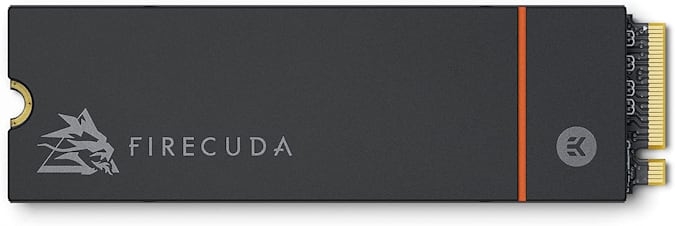
We haven’t been able to test this one ourselves, as it starts shipping “this summer,” but given Seagate is a trusted brand and has outright said its heatsinked drive supports PS5, we’re happy to include it on this list. Unfortunately, the list pricing on the 530s is high, at $160 for 500GB, $260 for 1TB, $540 for 2TB and $1,000 for 4TB. The non-heatsink version will retail at $140, $240 and $490, for the 500GB, 1TB and 2TB versions. These aren’t a million miles away from the RRP on other drives on this list that have a lower real-world price now, so we’d expect that you’ll be able to find some deals at similar rates down the line.

Samsung does not sell a 980 Pro with a heatsink attached, but it does have a fantastic reputation for reliability, and prices that are competitive with WD, Seagate and others on this list. Expect to pay around $130 for 500GB, $190 for 1TB, or $370 for 2TB.
Crucial P5 Plus

Crucial’s P5 Plus is another budget model, which missed out on the “best cheap SSD” spot thanks to PNY’s marginally lower prices. Again, this one has no heatsink, so you’ll need to supply your own. The 1TB drive is the sweet-spot option, coming in at $180, while the 500GB and 2TB drives will set you back $108 and $368, respectively.
Sabrent Rocket 4 Plus
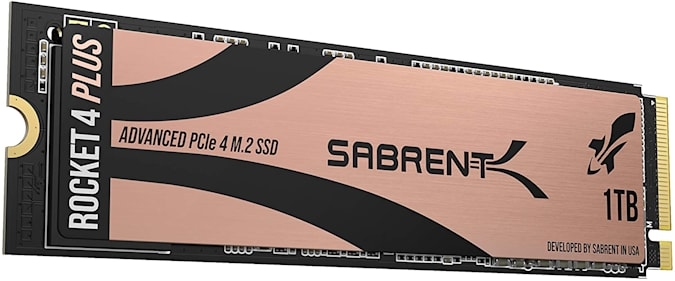
Sabrent sells a bunch of Rocket drives, but only the Plus model actually meets Sony’s requirements, so be sure you’re looking at the correct model before you buy. The Rocket 4 Plus’ heatsink is too chunky to fit in the PS5, so you’ll again have to fit your own cooling solution. Sabrent typically has aggressive pricing, but as of writing the Plus hasn’t seen any major discounts. The 1TB model can be found at around $180, the 2TB $360 and the 4TB for $900.
How to install an SSD in a PS5
As of writing, the first thing you’ll need to install an SSD is access to the semi-closed system software beta. From an admittedly small sample, I’ve yet to hear of people being denied access to this; everyone I know who’s applied was accepted within a week. You can enroll here if you’re in the US, or you can google “PlayStation 5 System Software Beta Program sign-up” to find your local sign-up link.
Once you have the beta on your PS5, installation of a PS5 SSD is fairly straightforward. Sony recommends a #1 Phillips or crosshead screwdriver, but this isn’t rocket science. Any crossed screwdriver of similar size will do fine.
Begin by powering down your PS5, unplugging everything, removing the stand and flipping it over to its underside. If you have the regular PS5, that’s the side with the disc drive, if you have the Digital Edition, it’s the side without the PlayStation logo cutout.
Sony has a video guide to popping off the outside cover here, but the gist is you gently lift up the opposing corners and slide the panel towards the flat end of the console. There’s a knack to this, and it requires very little effort or strength. If you’re not getting it, rather than force it just readjust your grip and try again. A member of our video team managed to break one of the tabs on our review unit doing this last November so… yeah, don’t force it.
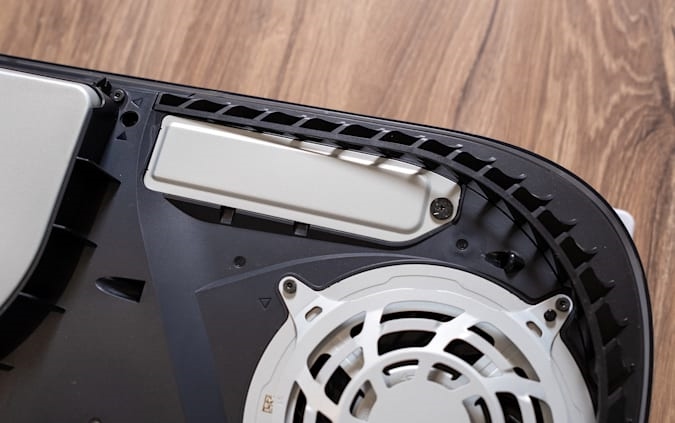
Once you’ve got everything open, you’ll see a rectangular piece of metal with a screw holding it in place. Remove that screw, and you’ll be able to access the drive bay.
You’ll see five holes inside, each numbered corresponding to the standard SSD drive lengths I mentioned earlier. The one numbered 110 will have a metal insert and screw inside. You need to unscrew the screw with a screwdriver, and then unscrew the insert with your fingers and move it to the relevant hole. Your eyes should tell you which is the right one for your drive, but it’s most likely going to be 80.
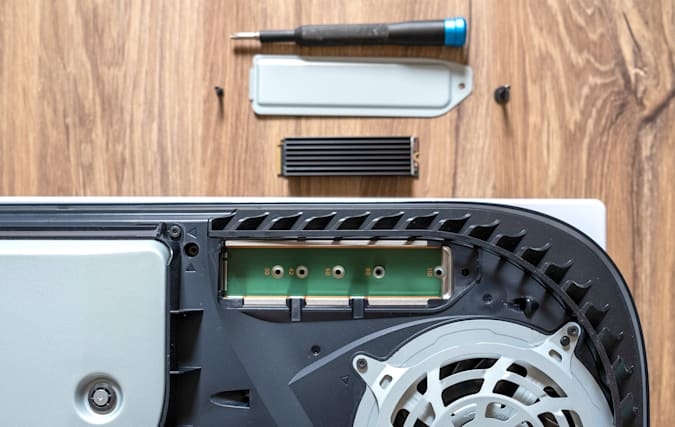
Then take your SSD — mine is a 980 Pro I bought on Prime Day with a $2 piece of aluminum attached to the top — and slot it in. The slot is at the edge closest to the number “30,” and SSDs are keyed to only fit in one way, so again, no force is required. If it’s not sliding in, don’t force it. You’ll notice the SSD doesn’t sit flat — that’s fine, and is as intended.
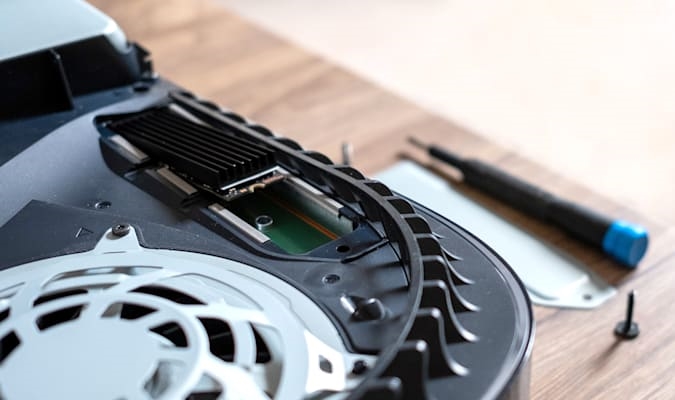
Once the SSD is seated, take the screw you removed from the insert, line it up with the little notch at the end of your SSD, and push down so it meets the insert. Give the screw it a few turns — it doesn’t need to be very tight — and you’re done.
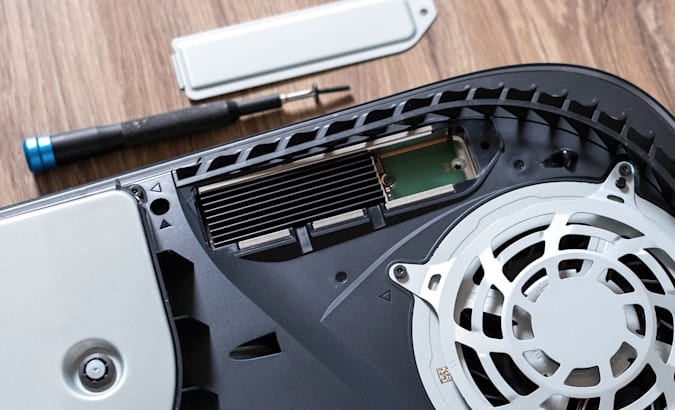
Replace the metal cover and screw it down, and then slide the plastic outer shell back on. When you first turn on the PS5, it’ll prompt you to format the drive. Do that! You have now successfully expanded your console’s storage, and can set about downloading and moving games to it. Personally, I moved all of the PS4 games I had to the new drive, along with all of my clips and screenshots. The PS5’s built-in SSD is always going to be the most compliant, so I’m keeping my important stuff there.
We’ll be updating this guide as more SSDs come to market and onto our test bench, so feel free to bookmark it for when you need it.
(36)

